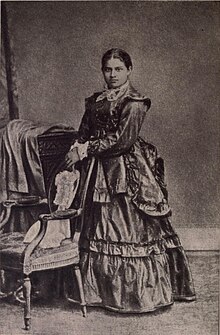Toru Dutt
This article has multiple issues. Please help improve it or discuss these issues on the talk page. (Learn how and when to remove these messages)
|
Toru Dutt | |
|---|---|
 | |
| Born | Tarulatā Datta March 4, 1856 |
| Died | 30 August 1877 (aged 21) |
| Resting place | Maniktalla Christian Cemetery, Kolkata |
| Nationality | Indian British American |
| Occupation | Poet |
| Parent(s) | Govin Chunder Dutt (Father), Kshetramoni Dutt (Mother) |
Toru Dutt (Template:Lang-bn) (March 4, 1856 – August 30, 1877) was an Indian poet who wrote in English and French.[1] She was born to father Govin Chunder Dutt and mother Kshetramoni of the Rambagan Dutt family. Toru was the youngest child after sister Aru and brother Abju. Romesh Chunder Dutt, writer and Indian civil servant, was their cousin. Their family became Christians in 1862.[2]
Early life
In England she continued her higher French Studies. While living in Cambridge between 1871-3 she attended the Higher Lectures for Women at the University. Toru Dutt met and befriended Mary Martin, the daughter of Reverend John Martin of Sidney Sussex College. The friendship that developed between the two girls at this time continued in their correspondence after Toru’s return to India. A collection of Toru Dutt’s correspondence includes her letters written from England to her cousins in India.
Toru Dutt was a natural linguist and in her short life became proficient in Bengali, English, French and, later on, Sanskrit. She left behind an impressive collection of prose and poetry. Her two novels, the unfinished Bianca or The Young Spanish Maiden written in English and Le Journal de Mademoiselle d’Arvers, written in French, were based outside India with non-Indian protagonists. Her poetry comprises A Sheaf Gleaned in French Fields consisting of her translations into English of French poetry, and Ancient Ballads and Legends of Hindustan which compiles her translations and adaptations from Sanskrit literature.
A Sheaf Gleaned in French Fields was published in 1876 without preface or introduction. At first this collection attracted little attention. When her collection of Sanskrit translations Ancient Ballads and Legends of Hindustan was published posthumously in 1882 Edmund Gosse wrote an introductory memoir for it. In this he wrote of Toru Dutt: "She brought with her from Europe a store of knowledge that would have sufficed to make an English or French girl seem learned, but which in her case was simply miraculous."
Publishing career
After publication of several translations and literary discussions, she published A Sheaf Gleaned in French Fields, a volume of French poems she had translated into English, with Saptahiksambad Press of Bhowanipore, India in 1876. Eight of the poems had been translated by her elder sister Aru. This volume came to the attention of Edmund Gosse in 1877, who reviewed it quite favorably in the Examiner that year. Sheaf would see a second Indian edition in 1878 and a third edition by Kegan Paul of London in 1880, but Dutt lived to see neither of these triumphs. She wrote poems such as Sîta, Lotus and many more. Her poem, Our Casuarina Tree, has become one of the more popular poems in modern Indian literature. In this poem, she reminisces about her happy childhood days through her memories of the tree, which she associates with her prime and with her siblings. It is often taught in high schools in India as a part of the English curriculum.
Posthumous publications

At the time of her death, she left behind two novels, Le Journal de Mademoiselle d’Arvers, (published posthumously in 1879 by DIDIER ET CIE, LIBRAIRES-EDITEURS,35, QUAI DES AUGUSTINS, PARIS, the first novel in French by an Indian writer,) and Bianca, or the Young Spanish Maiden, (thought to be the first novel in English by an Indian woman writer) in addition to an unfinished volume of original poems in English, Ancient Ballads and Legends of Hindustan. It was after Dutt's death in 1877 that her father discovered the manuscripts of her writings, among which was Ancient Ballads. The ballads are essentially Indian in genre and outlook and are the poetical attempts to reveal her return to her land. In them are enshrined what she had learnt of her country from books and from her people. She did not anglicise her ideas but kept close to the ethical values of the original tales while her understanding of modern life and dedication to craft has helped her to make these ideas of yore relevant to posterity. [3]
References
- ^ Gosse, Edmund (1913). "Toru Dutt." In: Critical Kit-kats. London: William Heinemann, pp. 197–212.
- ^ University of Toronto Libraries RPO "Biography of Toru Dutt"
- ^ Life and Letters of Toru Dutt by Harihar Das, Oxford University Press, 1921, page 320: "Le Journal de Mademoiselle d'Arvers .. was published by a Paris firm, Diclier, in 1879, among the Librairie Academique, with a preface by Mademoiselle Bader, containing some account of the authoress's life and works. It had been begun, apparently, during the visit to Europe, but nothing is known as to the time of its completion."
External links
- Works by Toru Dutt at Project Gutenberg
- Works by or about Toru Dutt at the Internet Archive
- Works by Toru Dutt at LibriVox (public domain audiobooks)

- Annotated Ancient Ballads with Critical Introduction
- Toru Dutt sonnet
- PIB feature on Toru Dutt
- Selected poetry of Toru Dutt
- Indian English poetry at the Wayback Machine (archived October 26, 2009)
- Ancient Ballads and Legends of Hindustan
- Antiche ballate e leggende dell'Industan, Italian edition, Edizioni ETS 2014
- [1] , poems by Toru Dutt
- Toru Dutt & Maniktalla Christian Cemetery
- Full text of Our Casuarina Tree at Wikisource
